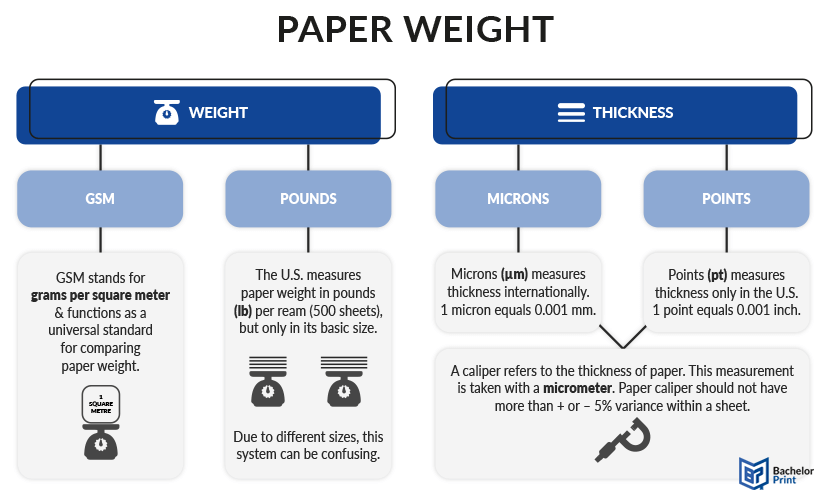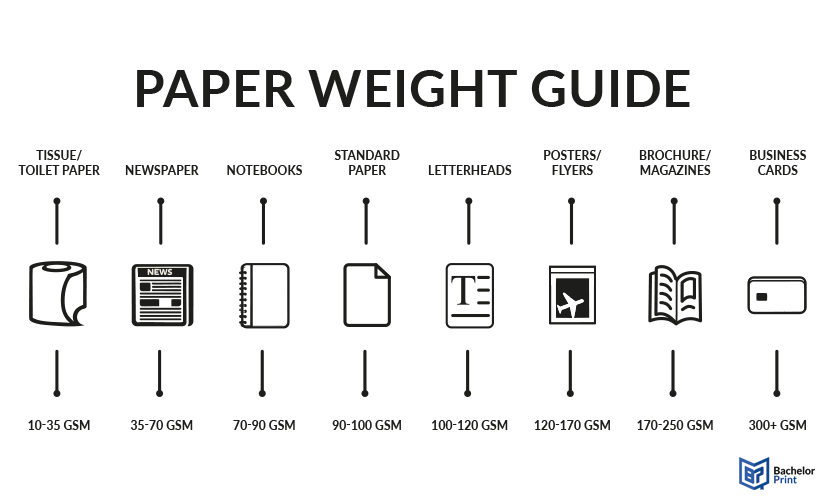
When considering paper for printing, stationery, or creative projects, one key factor that often plays a decisive role is the paper weight. In many cases, the decision on which printer paper to use goes beyond aesthetics. This article serves as both an introduction to the concept of paper weight and a guide to help you make informed decisions when selecting paper for your needs.
Definition: Paper weight
Paper weight refers to the mass of paper relative to its size. It is typically expressed in two common formats:
- Grams per square meter (gsm): This metric indicates the weight in grams of a single square meter of paper, measured by weighing the paper. It is widely used around international markets to compare the heft of different paper stocks.
- Pounds (lb) per ream: Predominantly used in the United States, this measurement classifies paper by the weight of a ream (usually 500 sheets) in its standard uncut size. Within this system, different paper types or paper grades, such as Bond, Cover, Index, Tag, and Text are defined by their specific ream weights.
In addition to weight, paper thickness is also an important factor when measuring the basis weight, commonly referred to as caliper, with a micrometer. It is categorized in:
- Microns (µm): Widely used internationally, a micron equals 0.001 mm.
- Points (pt): Primarily used in the U.S., a point equals 0.001 in.
A higher paper weight usually means a thicker, more durable product, while a lower paper weight may be more appropriate for everyday printing or projects where flexibility is valued.

Affordable document printing from $0.10
- Crisp text, vibrant colors & multiple paper choices
- No need to visit a shop; simply order online anytime
- Print documents, copies & reports with professional quality
Learn more!
Types
When discussing paper weight, there are two primary ways to classify paper internationally: light and heavy. However, we have gone a bit more in-depth below to show each type’s differences and uses.
Lightweight paper (around 35-90 gsm) is often used for everyday printing, newspaper, and cost-sensitive projects. Thin copy paper belongs in this category as well.
Midweight paper (around 90-170 gsm) is typically used for business correspondence, professional documents, corporate booklets, and magazines that need a balance between quality and economy. Standard printer paper belongs in this category.
Heavyweight paper (around 170-250 gsm) is a midway point between paper and cardboard. It is chosen for high-quality printing, such as brochures, posters, and premium marketing materials. Most basic types of printers are not designed to handle this type of paper.
Extra-heavy paper (300+ gsm) is reserved for specialty applications like invitations, business cards, or book covers, where maximum durability and luxurious appearance are important.

Cover weight vs. text weight
Paper for commercial printing in the United States can be grouped into two main paper grades: cover weight and text weight. Lightweight paper is traditionally measured in paper weight, whereas heavyweight paper is measured in paper thickness. So, knowing the difference between 100# text and 100# cover is crucial when buying printer paper.
Text weight
Text weight is a generic term that refers to paper that is thin, flexible, and lightweight. It’s typically used for books, magazines, newsletters, calendars, letterheads, and everyday printing. It can be easily folded and rolled, and provides a smooth surface, which makes it ideal for text and image reproduction. It typically ranges from 35 lb to 100 lb text and includes Book, Bond, Writing, Ledger, and Offset paper.
Although it can be labeled with the same number (e.g., 100#), text weight paper is lighter and more flexible than cover weight paper. If text stock has a basic size of 25″ x 38″ and 500 sheets at this size weigh 100 pounds, then the text weight paper is classified as 100# text or 100 lb.
Cover weight
Heavier paper grade is also referred to as “cardstock,” which is technically known as “cover.” This includes business cards, invitations, tarot cards, and book covers. Its increased rigidity makes it perfectly suitable for products that need to be more durable and visually impactful, as it can have a glossy or matte finish. It typically ranges from 80# cover to 130# cover and includes Bristol, Index, Tag, and Card paper.
Even with the same numerical rating (e.g., 100#), cover weight paper offers a significantly sturdier feel compared to its text weight counterpart. If cover stock has a basic size of 20″ x 26″, and 500 sheets at this size weigh 100 pounds, this classifies the paper as 100# cover or 100 lb.
Light paper stocks can also be divided into writing (informal use) and text paper, while heavy paper stock is subdivided into cover stock (often coated) and cardstock (often uncoated).
Note: These variations in basic sizes make the lb measurement quite complex, which is why gsm is often included in paper descriptions as well.
Paper grade
Paper grade describes the ways to classify paper based on its quality, materials, and purpose. While the international system simply grades paper by gsm, the U.S. system has many paper grades, each of which has a basic size and a basis weight. Each one will be explained below.
GSM
60 gsm
90 gsm
120 gsm
Bond
16 lb
24 lb
32 lb
Text
41 lb
60 lb
80 lb
Cover
22 lb
33 lb
44 lb
Bristol
27 lb
41 lb
55 lb
Index
33 lb
50 lb
67 lb
Tag
37 lb
55 lb
74 lb
In this table, for example, 24# bond is comparable in thickness to 60# text paper since they both have an approximate gsm of 90.
Bond paper
- Bond refers to uncoated copy paper
- Used for office printing & letterheads
- Standard sheet size of 17″ × 22″
Text paper
- Lightweight printer paper
- Used for books, brochures & flyers
- Standard sheet size of 25″ × 38″
Bristol paper
- Sturdy, smooth cardstock
- Used for greeting cards & invitations
- Standard sheet size of 22.5″ × 28.5″
Cover paper
- Medium to heavy cardstock
- Used for business cards & report covers
- Standard sheet size of 20″ × 26″
Index paper
- Smooth, medium-weight cardstock
- Used for index cards & forms
- Standard sheet size of 25.5″ × 30.5″
Tag paper
- Durable, stiff cardstock
- Used for tags & signs
- Standard sheet size of 24″ × 36″
Copy and print from $0.10
- High-quality copies & prints for any project
- Vibrant color prints or sharp black & white prints
- Online copy and print services delivered straight to your door
Learn more!
Paper thickness
The thickness of paper plays an important role in the overall paper weight. This thickness, known as caliper (not to be confused with the calipers tool), is measured using a micrometer or a thickness gauge and expressed in microns (international) or points (U.S.).
A single micron/point equals 0.001 millimeters/inches. These measurements are especially critical for thicker paper types, like business cards and coverstock. For example, business cards usually have a paper thickness of 14 to 16 pt, while a credit card is 30 pt.
FAQs
Paper weight is a way to describe how heavy a piece of paper is, which often relates to its thickness and use (e.g., printer paper vs. cardstock).
The weight is internationally measured in grams per square meter (gsm) or in the U.S. through basis weight (pounds), meaning the weight of 500 sheets (a ream) of paper in its basic size (which varies by paper type). However, gsm is more consistent because it doesn’t depend on the paper’s original size like basis weight does.
Examples:
- Standard printer paper is usually 75–90 gsm, while cardstock might be 200+ gsm.
- 20 lb bond paper means a ream of bond paper (17 × 22 inches) weighs 20 pounds.
A 28 lb paper (105 gsm) has a higher quality than regular printing paper (20 lb or 75 gsm), which makes it perfect for professional documents like business proposals, letterheads, presentations, reports, or resumes.
Paper grade refers to the category of paper based on its quality, materials, and intended use. Common paper grades include Bond paper, Text paper, Cover paper, and Bristol paper.